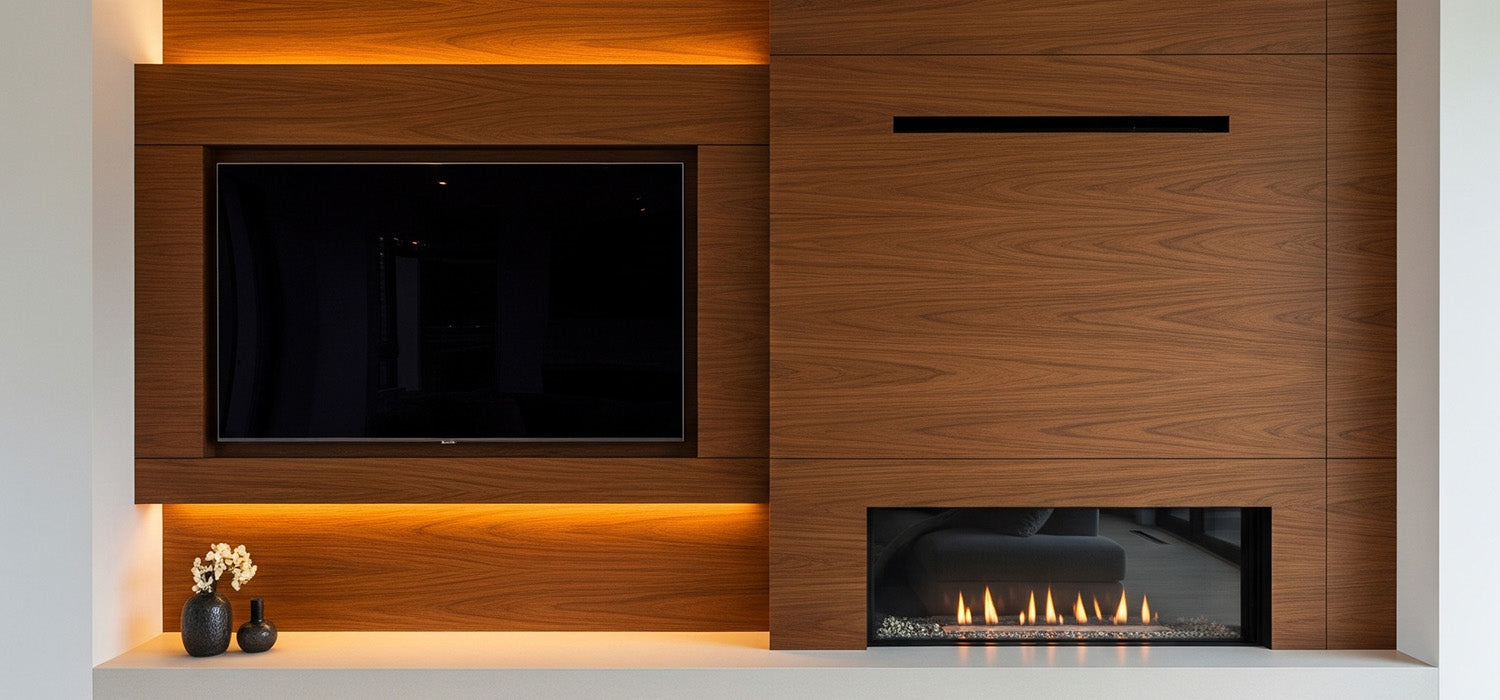
Media Wall Back Panels: Stylish Ideas to Elevate Your Space
Short answer? A media wall back panel is the sleek, stylish secret behind a clutter-free, wow-factor living room—especially when paired with a Media Wall Fire. It hides wires, boosts style, and says, “Yes, I have my life together.” Curious how? Keep reading for smart tips, trends, and design magic.
The Impact of a Feature Back Panel
A media wall without a back panel is a bit like a stage without scenery—technically it works, but it’s missing the drama.
That feature panel is where the magic happens. It frames the television, hides the mess, and adds that designer look we’re all after. Whether it’s a compact London flat or a family lounge in the suburbs, the right panel creates instant atmosphere.
Let’s break down how it transforms a room.
Adding Texture, Depth, and a Focal Point
A back panel isn’t just about looks—it’s about creating visual depth.
Slatted wood, textured stone, or even plush fabric panels add layers and shadow. They make your media wall pop instead of blending into the background.
It’s the difference between a screen stuck on a plain wall and a fully designed feature you’d expect in a show home.
How a Back Panel Can Make a Room Look Wider or Taller
Design tricks aren’t just for architects.
Vertical slats naturally draw the eye upward—perfect if you’re dealing with low ceilings. Want the room to feel wider? Go for horizontal patterns or wide-format panels that stretch wall-to-wall.
We’ve seen narrow city flats transformed just by flipping the direction of the wood grain.
Popular Back Panel Materials
Material choice is where you make the media wall truly yours.
Whether you're after sleek, rustic, minimalist or grand, the finish sets the tone. Let's explore some popular options that work across all styles and budgets.
Wooden Slat Panels: The Modern Choice
You’ve probably seen these all over Pinterest—and for good reason.
Wooden slats bring texture, warmth, and a modern architectural edge. They suit everything from clean Scandinavian setups to rich, moody home cinemas.
Better still, they’re timeless. These panels won’t date the way some trendy wallpapers might.
Oak, Walnut, and Black Finish Options
Each timber tone tells a different story.
Oak is light, fresh, and clean—ideal for open, airy living rooms. Walnut adds richness and depth, perfect for pairing with leather sofas and brass accents. And black slats? Bold, striking, and endlessly stylish—especially when offset with warm lighting.
Pick one that works with your floors or cabinetry for a seamless look.
Acoustic vs. Non-Acoustic Slats
Slatted panels aren’t just for show.
Acoustic versions come with felt backings that absorb sound. That’s a game-changer if your space has echo or you're building a home cinema. Non-acoustic versions look the part but don’t offer the same audio benefits.
If you love a loud action film or listen to music through a soundbar, acoustic panels are a smart shout.
Split-Face Tiles or Stone Veneer for Texture
Stone panels are all about drama and texture.
Split-face tiles catch the light beautifully and give a lovely, natural finish. Think spa hotel lobby meets cosy living room. If you’ve got a Media Wall Fire underneath, the contrast between flame and stone is stunning.
Stone works especially well in rustic or industrial schemes.
Venetian Plaster or Microcement for a Seamless, High-End Look
For a smoother, sleeker feel, you can’t go wrong with Venetian plaster or microcement.
These materials create a seamless wall with a soft sheen—almost like polished concrete. They’re perfect if you want your TV to blend in rather than stand out. We’ve seen these paired with floating consoles and ultra-thin bezels for a gallery-worthy effect.
And yes, they photograph beautifully.
Feature Wallpaper or Murals
Wallpaper might not sound groundbreaking—but done right, it makes a big impact.
Choose a bold geometric print or a textured mural that adds personality without overpowering the space. It’s a great choice if you want to create a unique, renter-friendly media wall that doesn’t involve power tools.
Pair it with a slimline console and you’re done.
Upholstered Fabric Panels for a Softer, Cinematic Feel
Want a more luxurious, cosy vibe?
Upholstered panels absorb sound and add a plush, cinematic quality. Think navy velvet or deep grey felt. They’re especially popular in dedicated media rooms or living rooms that double as home theatres.
We’ve even seen them used floor-to-ceiling behind blackout curtains for a true cinema feel.
Design and Integration
The beauty of a media wall back panel is in the details.
Done well, it’s more than a backdrop—it becomes part of your home’s architecture. That means smart lighting, clever cable management, and a layout that’s both practical and beautiful.
Combining a Back Panel with LED Lighting
Lighting can make or break your media wall.
A simple LED strip behind your TV adds glow and mood, without overwhelming the screen. Want something bolder? Add recessed lighting along the top edge of your panel or behind floating shelves.
Use warm whites for comfort, or colour-changing strips for a playful touch.
How to Seamlessly Manage Cables with a Back Panel
Let’s face it—nothing ruins a good setup like messy wires.
A back panel lets you hide it all. You can run cables behind the slats, through hidden chases, or within trunking that’s built into the wall. Use recessed power points and HDMI ports to keep everything neat.
If you’re investing in this look, go all-in on the clean lines.
Full-Width vs. TV-Width Panels
Full-width or focused?
Full-width panels make a grand statement. They stretch the length of the wall and give the whole space structure. TV-width panels, on the other hand, work well in smaller spaces or open-plan layouts.
Think about how you want the media wall to sit in the room—hero feature or subtle accent?
Real-Life Back Panel Inspiration
Still not sure which way to go? Here are a few setups we’ve loved recently:
-
A black slatted panel with brass wall sconces and a matte electric fire underneath
-
Soft oak slats paired with neutral shelving and hidden LED lighting
-
A concrete-effect microcement wall behind a floating TV bench and soundbar
-
Navy velvet upholstered panels with in-built speakers and blackout blinds
-
A full-height mural of a misty forest for a calming, natural media zone
Final Thoughts
A media wall back panel isn’t just a design extra—it’s the feature that ties everything together.
From hiding cables to adding texture, lighting, and focus, it takes a plain wall and turns it into the centrepiece of your home. Whether you're working with timber, stone, fabric or a touch of bold wallpaper, the key is to match the material with your lifestyle.
Take time to plan it properly, and your media wall won’t just be functional—it’ll be unforgettable.
Other content we think you'll love
- Media Wall Accessories: Style, Function and Wow Factor
- Media Wall Accessories Ideas: How to Style Your Space with Flair
- Media Wall Acoustic Panels: Enhance Sound & Style at Home
- Creative Media Wall Alcove Ideas for Stylish, Functional Homes
- Media Wall Alcove Ideas: Stylish Designs That Maximise Space
- Media Wall Access Panels: Why You Shouldn’t Skip This Clever Feature
- Media Wall Boards: The Complete Guide to Strong, Safe Builds
- Media Wall Box: The Secret to a Sleek, Cable-Free Setup
- Built-In Media Walls: Transform Your Living Room with Style and Function

